Dandan-Uiliq: The Sino-Japanese Mission
Zhang Yuzhong

Located deep in the Taklamakan, the site of Dandan-Uiliq was discovered by the Swedish explorer Sven Hedin in 1896. The British archaeologist, Aurel Stein, used Hedin’s information to find the site in 1900 and carried out a more detailed survey, published in Ancient Khotan (Stein 1907). In 1905 it was visited by the American, Ellsworth Huntington (Huntington 1907), and in 1928 by the Swiss team of Emil Trinkler and Walter Bosshard (Gropp 1974). However, after this it remained undisturbed for nearly seventy years until archaeologists from Xinjiang found it again in 1996. In October 2002 a Sino-Japanese project started to research and protect the site. This resulted in a 2009 Japanese and Chinese language publication, and, in November of that year, an international academic seminar hosted by the Archaeology Research Institute of Peking University, entitled ‘Archaeology of the Western Regions from the Han to Tang Periods: Niya and Dandan-Uiliq’. This marked the successful completion of this seven-year project.
Conservation and Research on the Wall Paintings
The circumstances leading to this Sino-Japanese Project could be seen as a result of Buddhist karma. In 2002 the Niya Research Team of Xinjiang Cultural Relics Bureau and Bukkyo University visited Dandan-Uiliq and found the corner of a beautiful mural partially exposed owing to wind-erosion. A team from the Xinjiang Institute of Archaeology (XJIA) subsequently carried out rescue archaeology and removed the murals to Urumqi. It was serendipitous that experts of Japan and China were able to work together to protect and research this newly-revealed painting.
A Sino-Japanese collaborative project to conserve and research these paintings was approved by SACH in October 2003, led jointly by Zhang Yuzhong from Xinjiang and Kojima Yasutaka from Japan. In March 2004 a team of archaeologists, art and cultural heritage conservation experts from XJIA who had worked on uncovering, removing and investigating murals from Dandan-Uiliq formulated a programme for their conservation. In May 2004, the programme was validated following a meeting of cultural preservation experts at Beijing Science and Technology University chaired by Professor Wang Danhua. Lessons were learned about materials and techniques from other successful projects, including the conservation of murals at the Amida Hall of Hōkan-ji (法界寺) in Kyoto, the Sino-French collaboration on the Karadong murals in Xinjiang, and the work on Western Han period murals in Henan. The conservation of the Dandan-Uiliq material can be seen as the exchange and integration of technical knowledge between China, Japan and France.
The programme started in early November 2004 and the conservation and restoration of all the murals was completed within eighteen months by a team of Japanese conservators. They worked on thirty pieces, comprising in total about ten-square metres of paintings. On 11 July 2006 the Xinjiang Cultural Relics Bureau convened a meeting in Urumqi entitled ‘Review of the Conservation of the Dandan-Uiliq Wall Paintings’. After reports and demonstrations of the conservation work, the experts from China and Japan reached a consensus that the Dandan-Uiliq murals have historical, artistic and technical value and the repair and restoration work was timely. They agreed that the work, having been based on the experience of previous projects by Japanese, French and Chinese teams, was of high quality and that it had established new standards for mural protection that could have wider value. They therefore recommended that the project be expanded in scope to consider the conservation and research of murals throughout Xinjiang.
Following conservation, the paintings were exhibited in 2005 in Tokyo, Kobe and Okayama in Japan, in 2008 in Taiwan History Museum, and in 2009 in Brussels in the Europalia festival, all exhibitions receiving an enthusiastic response. The research results were discussed at Sino-Japanese symposia held in 2005 and 2007 at Bukkyo University, during which scholars agreed that the murals should be described as ‘new treasures of Buddhist art from the western regions.’ Professor Ando Yoshiko of Bukkyo University emphasized the paintings’ importance in providing evidence for early exchanges between China and Japan. Japanese scholars long argued that the style of murals at Hōryū-ji (法隆寺)in Japan are in the style of Yuchi Yiseng 尉迟乙僧 (fl. 7th/8th century), a mural painter from the western regions. However, no objects had been discovered to support this. The newly-unearthed murals from Dandan-Uiliq and Domoko with their specific style provided support to the hypothesis that the Yuchi painting style from Khotan already had had an influence by the Tang period on Japanese mural production. In early 2005 episode 4 of the NHK and CCTV co-production, ‘The Silk Road’, gave a special report on the new archaeological discoveries of the Buddhist temples at Dandan-Uiliq and Domoko.
Joint Archaeological Work

In October 2004, when CCTV and NHK were shooting their new Silk Road series, they took some of the Sino-Japanese experts from the project to film at Dandan-Uiliq. Although it had only been two years since the team’s last visit, the damage was considerable. Both Stein’s original investigations and the results of our project work showed that the large size of Dandan-Uiliq is unusual among Buddhist sites of the same period in Xinjiang. In 2002 when the murals were discovered, experts in China and abroad agreed that this is one of the most important sites of the region and that enhanced security of the site and further archaeological investigation were both essential. However, given the remoteness of the site, implementing effective protection is extremely difficult.
We believed that a full survey of the site recording all its features was essential to provide the basis for future work. The survey was duly carried out by the Sino-Japanese team in October 2005 and 2006, each for a period of about two weeks. Surveying equipment and GPS was used alongside field reconnaissance to complete the work.
During the survey in 2006 three areas were also selected for excavation. The finds included murals, wooden tablets in Chinese, woodslips in Khotanese, and paper manuscripts. Although not large in number compared to those acquired by the foreign explorers, these finds have provided important new evidence on the arrangement and structure of Dandan-Uiliq. Of particular use are the data from five samples of building materials taken from different areas of the site and subjected to Carbon-14 dating at Peking University. The overall date range was 410 to 870, while four were within the range of the seventh to ninth centuries, providing evidence for understanding the chronology of Dandan-Uiliq. Seventy features were recorded, including one wall, thirty dwellings, fifteen Buddhist shrines, two furnaces, eleven kilns, ten orchards of various sizes and one fence. In accordance with the plan, full reports were published in Chinese and Japanese (Xinjiang 2007 & 2009). In 2012 the Chinese report was awarded the Ninth Award of Excellence in Philosophy and Social Sciences of Xinjiang Uygur Autonomous Region.
Zhang Yuzhong is Deputy Director of the Xinjiang Institute of Archaeology
For publications relevant to this articles see References.
Archaeology of the Southern Taklamakan: Hedin and Stein’s Legacy and New Explorations
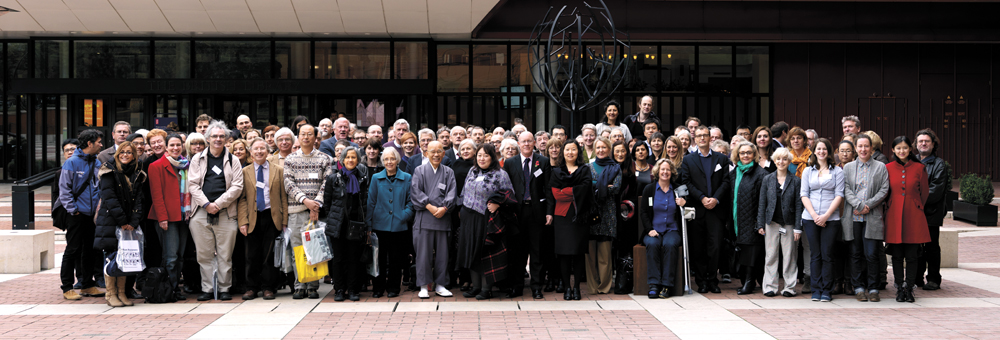
This two-day conference, jointly organised by IDP at the British Library, SOAS of the University of London and the Xinjiang Institute of Archaeology, was held in London from 8–10 November 2012. It brought together an interdisciplinary group of scholars, including field archaeologists from the Sino-Japanese and Sino-French excavations of recent decades, archivists, curators and historians working on the Hedin and Stein collections, and historical geographers, art historians, and historians from universities with a strong research record in this area and attracted over 150 delegates. A full report will be given in the next issue of IDP News. Audio and powerpoints of the lectures are also available on the conference website.
Supported by the Chiang Ching-Kuo Foundation for International Scholarly Exchange, the Sino-British Fellowship Trust and the Arts and Humanities Research Council.
In the Footsteps of Grünwedel: Conservation and Research on Central Asian Wall Paintings
Lilla Russell-Smith
This three-year project at the Museum für Asiatische Kunst (AKu, Asian Art Museum, National Museums in Berlin) was concluded with an exhibition and publication. In this article I highlight the most important results of this project and also briefly discuss other projects and collaborations concerning the Turfan Collection in the Museum.
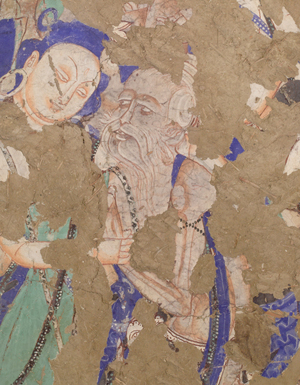
The four German expeditions under the leadership of Albert Grünwedel (1856–1935), and later Albert von Le Coq (1860–1930) travelled on the northern Silk Road between 1902–14. The last boxes of finds from their expeditions arrived in Berlin just at the start of the First World War. The wall painting collection is probably the most important, but archaeological material, architectural fragments, painting fragments on silk and paper as well as a large textile collection make up the Turfan Collection of the Museum für Asiatische Kunst1. The manuscripts and text fragments were divided between the Museum, the National Library and the Berlin Brandenburg Academy of Science and Humanities, whose Turfan Research Group led by Desmond Durkin-Meisterernst needs no introduction here.
The Museum’s collection has only been partially published and there are plans to make it more widely available through online and print publications over the coming years. A selection of the expedition photographs are already available on the IDP website as the result of our first cooperation within the IDP-CREA Project (2008–9). The Turfan Research Academy is now planning an exhibition and catalogue of historical photographs showing street life and portraits of locals in October 2012 in Urumqi. A publication of the same photographs is being prepared by Caren Dreyer (Archive, AKu) in German and English together with Ingrid Schindlbeck, Curator of the Central Asia collection of the Ethnological Museum, Berlin, to be published this year. Caren has also written a book about the newly discovered diary for 1909 written and illustrated by Grünwedel, and published for an international conference as a gift. This booklet was found in Munich in the family collection by Rudolf Reischl, the grandson of Grünwedel. He contacted us with this and other interesting finds, some of which are on display in the exhibition. Grünwedel drew a composition based on his sketches from the Silk Road for each month merging Central Asian motifs with the then fashionable Jugendstil, and composed a poem telling, for example, how the local gods are called to rise up against the foreign intruders (the German expeditions), who disturb their peace. In another drawing Grünwedel is attempting to sketch surrounded by the deities, but manages to draw only the ‘Struwwelpeter’, the popular German children’s book character.
The largest part of the collection comes from the Kucha region and the wall paintings are the most important. This area was a very important cultural centre in the third to ninth centuries. The Kizil caves and the smaller cave temple sites of Kumtura, Simsim and Toyok are not easy to reach even today. The caves are situated in deep valleys, often at a fair distance from each other. Research shows that the caves were built in groups: a ritual temple was accompanied by a cave for dwelling and an additional cave may have been used for the storage of materials. Only a selection of caves are open for tourists but our museum team (Lilla Russell-Smith, Toralf Gabsch, Caren Dreyer, Gerhard Prückner and Satomi Hiyama) was allowed to visit as many caves as possible in the two weeks we spent in the area in September 2011. Zhao Li, Deputy Director of the Kucha Research Academy, accompanied us, and we benefited greatly from her knowledge of the site. Zhao Li is now working at our museum for one year to prepare a joint publication of our wall painting fragments from the Kucha area. She presented the first results of her research in 2002, researching the exact provenance of the fragments within the caves.
The journey undertaken to China was part of the ‘KUR Project’ (Conservation and restoration of mobile cultural assets), a three-year research program undertaken at our museum (2008-12). The project was supported by the Kulturstiftung des Bundes and the Kulturstiftung der Länder. Project partners included the Rathgen Research Laboratory of the National Museums in Berlin, the Bundesanstalt für Materialforschung und -prüfung (BAM), the Universität Paderborn and the Universität Potsdam.
Among the finds of the German expeditions was the famous wall painting of donor figures of Tocharians from the ‘Cave of the 16 Swordbearers’ (Höhle der 16 Schwertträger, Kizil Cave 8). Their resemblance to knights from the European Middle Ages struck a chord in Germany, and they have been reproduced in many books ever since. Newly restored wall paintings from the corridors and the back of this cave were the focus of the project, and are now presented in the exhibition. Only one wall painting could not be restored, as it is part of the display in the permanent gallery in Dahlem, and the ceiling of the back hall will also have to be restored in the future. Toralf Gabsch managed the project, Ulf Palitza, Barbara Hausmann and Gerhard Prückner, freelance conservators, researched and restored the wall paintings.
During the project a new conservation method was developed by Ulf Palitza and Gerhard Prückner. This involved partially dismounting the paintings from the plaster support backings applied in the 1920s. In some cases the support has been retained, but all additions resulting from earlier conservation were removed. This has provided a rare opportunity to undertake a scientific examination of the materials, pigments and glues. Ellen Egel, working at the Rathgen Research Laboratory has researched the effects of applying nylon layers (Caparol and Calaton) in the 1970s. We have also collaborated with a related project entitled ‘The painting materials and technical studies of Kizil murals research project’ organised in Japan, led by Ichiro Sato (Tokyo University of the Arts) and Yoko Taniguchi (University of Tsukuba), other participants include Ikuko Nakagawara (Nagoya University).
After the scientific examination was completed the damaged areas were filled in with an earth-straw mix, following the original methods. Grünwedel’s huge sketches prepared on tracing paper in Kizil were copied onto transparent foil. Covering the original, this allows for seeing any discrepancies resulting from the reassembling of the fragments that took place in the 1920s or during conservation after the Second World War. The areas traced in-situ by Grünwedel — but subsequently damaged during transport or during the Second World War — can then be copied by punching holes through the foil following the pattern, and then patting this with white powder — exactly as stencils would have been used in Central Asia in the Middle Ages (the paper stencil from Dunhuang in the collection of the British Museum is well-known). This leaves white dots on the surface that are connected by the conservator. As the next step another foil is used to cover the surface and the damaged areas are cut out. Each colour is then printed on with the help of a roller or a stamp, leaving a pattern of even dots on the previously empty areas. This allows the viewer to enjoy the beauty of the painting from a distance, but the new additions are clear from close-up. Even very large damaged areas can be reconstructed with this reversible method: the printing technique allows for that more easily than the so-called ‘tratteggio’ technique, where hand-painted thin parallel lines indicate the added parts. The new printing technique has to be used together with ‘tratteggio’ at the edges and for showing human skin, where it is deemed appropriate by the conservator. This technique is still beingdeveloped, and we look forward to exchanging information with other collections facing similar problems.
This new method for conservation has now been adopted by the Museum for other projects as well. ‘Connecting Art Histories in the Museum’ is a new cooperation of the National Museums in Berlin with the Art History Institute (KHI) in Florence (a Max Planck Institute). Our first KHI Fellow has been Hiyama Satomi. Her PhD research is on the ‘Painter’s Cave’ (Malerhöhle, Kizil Cave 207). She has been reconstructing the iconographic programme with the help of Grünwedel’s sketches, historical photographs and original fragments. Her close collaboration with Jana Bulir, a freelance conservator working at our museum, has enabled them to reconstruct the original colours. This is very important for understanding the original meaning of the wall paintings: it has become clear that the same person can be shown twice in one scene. Jana Bulir also wrote her dissertation as part of her conservation studies about this cave, and she used the newly developed methods for restoring the fragments. We hope that both of them can continue their collaboration at our museum. Satomi continues her research at Peking University for six months, and will then return to the university and to the museum funded by the Gerda Henkel Stiftung early next year.
Textual research is of course also very important for understanding the context in which the art of the given period developed. In the exhibition we are showing a translation prepared by Ching Chao-jung and Ogihara Hirotoshi of a wooden tablet inscribed in Tocharian. Originally a seated Buddha was painted to cover the text, but this was removed in the 1960s in order to expose the Tocharian text. Ching and Ogihara have identified the text as a contract concerning the sale of a male person, probably a child, to a Buddhist temple. A full translation and interpretation will be published shortly.
The ceiling of the back hall of Kizil Cave 8 was originally vaulted, and one half is now in the Berlin collection. However the pieces were flattened for transport. These fragments are in the exhibition, but have not been restored. It remains a challenge to display them in a new reconstruction planned for the new museum, the Humboldt-Forum, in the centre of Berlin. There are plans to design a reconstruction, and the ceiling will appear above the visitors. Exactly how this will work has still to be discussed with the newly appointed interior designers, Ralph Appelbaum Associates Inc. We hope that conservation and research of the wall paintings can continue as we prepare for the Humboldt-Forum. In contrast to the exhibition now in Dahlem, we would like to show wall paintings in groups from caves and in context, with more explanation. We also hope to show more items than currently on show in the permanent gallery, especially the sculptures from the Kizil and the Turfan areas. The technology of wall painting and sculpture production will also be explained with the help of molds from Shorchuk in our collection. Furthermore it is planned to have a study collection open to the public displaying the objects that cannot be included into the Central Asia exhibit.
Finally, a new official agreement with the Hermitage in St Petersburg allows the cataloguing of the Central Asian material together with the Russian colleagues. This also includes wall painting fragments and other artefacts (especially manuscripts) that were taken to the Soviet Union in 1945 from Berlin. We are very much looking forward to working together with Central Asia researchers on projects in preparation for the new Humboldt-Forum galleries. It is hoped that even more of this unique collection can be shown and interpreted than is now possible.
Notes
1. Although commonly referred to as the ‘Turfan Collection’, it includes objects from other areas visited by the German expeditions, notably the region of Kucha.
Lilla Russell-Smith is Curator of Central Asian Art at the Museum für Asiatische Kunst, Staatliche Museen zu Berlin.
For publications relevant to this article see References.
Scientific Analysis of the Kizil Wall Paintings of the Asian Art Museum, Berlin
Yoko Taniguchi, Ellen Egel, Stefan Simon
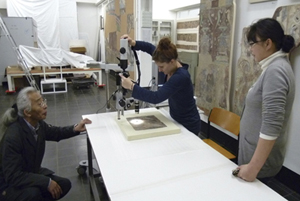
Many Buddhist monasteries decorated with wall paintings are known in Chinese Central Asia especially around the Tarim basin, notably in the vicinity of Turfan, Kucha, Khotan and Miran. The Kizil caves near Kucha flourished over several centuries because of economic and cultural interaction with other regions. The painting techniques were strongly influenced by India, Iran and China.
The Kizil wall paintings were created using ‘frecso secco’ or ‘a secco’ technique. This is different from Roman frescos that required organic binders to fix pigments onto the painting surface. The ‘a secco’ technique was widely used along the Silk Road at sites including Bamiyan (Afghanistan) and Dunhuang (China). Caves were excavated from soft conglomerate cliffs and their inner surfaces covered with earthen plasters. White ground was then applied before the colours were applied. Most of the paintings are now degraded and faded. However, it appears that originally the Kizil paintings were extremely rich in colour and used an abundant amount of gold leaf for decoration.
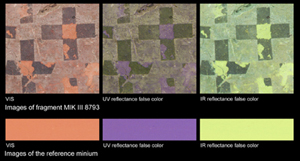
In order to examine the techniques and materials of Kizil paintings in detail, scientific analysis has been undertaken since the 1930s by Rutherford Gettens at the Fogg Museum on their collection pieces. The Japanese chemist, Kazuo Yamazaki, also analysed some fragments from Kizil in 1960. Using chemical methods that were available at that time (microscopy and chemical tests), both found gypsum [CaSO4 • 2H2O] as the white ground as well as chrysocolla [CuSiO3 • 2H2O] as green pigment.1,2 In the 1970s Josef Riederer analysed the collection of the Asian Art Museum of Berlin, including the Kizil paintings. He identified white materials as gypsum [CaSO4 • 2H2O], anhydrate [CaSO4] and, rarely, lead white which he suggested originated from Eastern China3. He also reported that the blues were formed from lapis lazuli and indigo, originating in western Central Asia4. Pigments and painting techniques reflect the cultural background and this can help us understand the cultural value of each painting fragment.
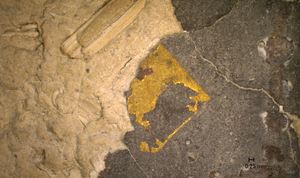
Within the framework of a German-Japanese collaborative research project, Asian Art Museum, Rathgen Research Laboratory and a Japanese team from the three organizations have started scientific diagnosis of Kizil paintings using non-invasive techniques. Multispectral imaging with high resolution photographs allows us to create a detailed digital documentation of the paintings and carry out a first screening of pigments used. Then particle information and detailed surface information are obtained with a digital microscope. Selected areas are analysed with micro-X-ray fluorescence (µ-XRF) system to determine the elemental composition of the different colours.
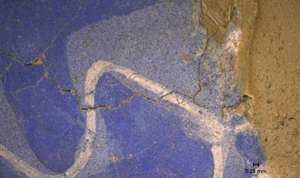
The bright orange color from fragment MIK III 8793 could be identified as minium by comparing the behaviour of this colour in the different images (VIS, IR false colour and UV false colour) with reference standards (Fig. 2). Moreover, it was possible through µ-XRF measurement to characterize the black crosses in the VIS photograph of fig. 2 as tin metal leafs.
Fragment MIK III 9189, Cave 224 (see p.4), presents considerable damage. One explanation could be that it was caused by the looting of gold and microscopy revealed traces of this metal at several locations (Fig. 3). The blue pigment was identified by means of multispectral imaging as natural ultramarine from lapis lazuli, certainly used in different qualities and in mixture with a white pigment to obtain a light coloured tone as seen in Fig. 4 & 5.
With these techniques it was possible to identify some of the painting materials and unique areas and these should be subject to further examination with other analytical methods in future. Vivid colours and decorations with gold and tin metal leaf were recovered from these fragments, reminding us again of the prosperity of Kizil in this period.

Notes
1. Gettens 1937–38: 285-287, 292.
2. Yamazaki 1960: 31-33.
3. Riederer 1977: 359-360.
4. Riederer 1977: 372-375.
Yoko Taniguchi is Assistant Professor, Graduate School of Humanities and Social Sciences, University of Tsukuba. Ellen Egel and Stefan Simon are at Rathgen Research Laboratory, National Museums Berlin.
References
- Neville Agnew (ed.). Conservation of Ancient Sites on the Silk Road: Proceedings from the Second International Conference on the Conservation of Grotto Sites, August 25–30 2004, Los Angeles: Getty Conservation Institute 2010 and online.
- Chhaya Bhattacharya. Art of Central Asia, with Special Reference to Wooden Objects from the Northern Silk Route, Delhi 1977.
- Chhaya Bhattacharya-Haesner. Central Asian Temple Banners in the Turfan Collection in the Museum für Indische Kunst Berlin, Berlin 2002.
- Ching Chao-jung and Ogihara Hirotoshi. ‘A Tocharian B Sale Contract on a Wooden Tablet.’ Journal of Inner Asian Art and Archaeology 5 (2010) (forthcoming).
- Caren Dreyer. Albert Grünwedel: Zeichnungen und Bilder von der Seidenstraße im Museum für Asiatische Kunst, Berlin 2011.
- Toralf Gabsch (ed.). Auf Grünwedels Spuren: Restaurierung und Forschung an Zentralasiatischen Wandmalereien, Leipzig 2012.
- R. J. Gettens. ‘The Materials in the Wall Paintings from Kizil in Chinese Turkestan.’ Technical Studies in the Field of Fine Arts 6 (1937-1938): 281-94.
- Rajeshwari Ghose. Kizil on the Silk Road: Crosswords of Commerce and Meetings of Minds, Marg Foundation 59.3 (March 2008).
- Gerd Gropp. Archäologische Funde aus Khotan Chinesisch-Ostturkestan. Die Trinkler-Sammlung im Übersee-Museum, Bremen. Wissenschaftliche Ergebnisse der Deutschen Zentralasien Expedition 1927/28, Teil 3. Bremen: Friedrich Röver 1974.
- Zsuzsanna Gulácsi. Manichaean Art in Berlin Collections: A Comprehensive Catalogue, Turhout: Brepols Publishers 2001.
- Ellsworth Huntington. The Pulse of Asia: A Journey in Central Asia Illustrating the Geographic Basis of History, Boston and New York: Houghton, Mifflin and Co. 1907.
- J. Riederer. ‘Technik und Farbstoffe der Frühmittelalterlichen Wandmalereien Ostturkistans.’ Beiträge zur Indienforschung 4 (1977): 353–423.
- M. Aurel Stein. Ancient Khotan, Oxford: Clarendon Press 1907; reprint, New Delhi, 1981.
- Giuseppe Vignato. ‘The Wooden Architecture of the Kizil Caves.’ Journal of Inner Asian Art and Archaeology 1 (2006): 11-27.
- Xinjiang Institute of Archaeology and Bukkyo University Niya Research Team (edd.). 中国新疆文物考古研究所,日本佛教大学尼雅遗址学… 编. Dandan-Uiliq: Report on the Sino-Japanese Archaeological Research. 《日中共同丹丹乌里克遗址学术调查报告书》(Japanese) Tokyo 2007 and 《 丹丹乌里克遗址—中日共同考察研究报告 》(Chinese) Beijing: Wenwu Publishers 2009.
- K. Yamazaki. ‘Pigments of the Wall Paintings from Western China’, The Journal of Art Studies (Bijutsu Kenkyu) 212 (1960): 31-3.
- Kazuya Yamauchi, Yoko Taniguchi, Tomoko Uno (edd.). Mural Paintings of the Silk Road: Cultural Exchanges Between East and West, London: Archetype Publications Ltd. 2007.
- Susan Whitfield. ‘A Place of Safekeeping? The Vicissitudes of the Bezeklik Murals’. In Neville Agnew 2010.
- Zhang Yuzhong, Qu Tao and Liu Guorui. ‘A Newly Discovered Buddhist Temples and Wall Paintings at Dandan-Uiliq in Xinjiang.’ Journal of Inner Asian Art and Archaeology 3 (2008): 157–170.
- Zhao Li. ‘Verification of the Original Locations of the Murals from Caves in Kizil Kept in the Museum für Indische Kunst, Berlin’ in Turfan Revisited: The First Century of Research into the Arts and Cultures of the Silk Road, ed. Desmond Durkin-Meisterernst et al., Berlin 2004: 418-23.
Buddhist Art Forum
A four day symposium on all aspects of Buddhist art was hosted by the Courtauld Institute of Art, London, from 11–14 April 2012. Generously funded by the Robert H. N. Ho Family Foundation, the forum brought together art historians, archaeologists, text historians, conservators, curators and Buddhist practitioners from around the world.
The third day was devoted to the conservation of Buddhist art and in one session on Dunhuang, Wang Xudong, Deputy Director of the Dunhuang Academy, and Lorinda Wong of the Getty Conservation Institute discussed the issues facing the preservation of the Dunhuang wall paintings given rising visitor numbers and the work done to address these issues by the Academy and the GCI. Susan Whitfield also gave a presentation on the work of IDP.
The papers will be published in a conference volume in 2013, details of which will be given in IDP News.
During the conference an announcement was made of a new MA programme at the Courtauld in the history and conservation of Buddhist art, also funded by the Robert Ho Foundation.
Publications
The Silk Road: A New History
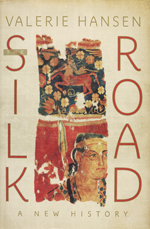
Valerie Hansen
New York and Oxford : Oxford University Press 2012.
HB, 320 pp., 61 b/w, 19 colour, £20
ISBN: 978-0-19-515931-8
The Silk Road: Key Papers: The Pre-Islamic Period
Valerie Hansen (ed.)
Leiden: E. J. Brill 2012.
HB, 2 vols., 414 pp. 292 pp., €295, $419
ISBN: 978-1906876234
The Archaeology of Power and Politics in Eurasia: Regimes and Revolutions
Charles W Hartley, G Bike Yazicioğlu, Adam T Smith (edd.)
Cambridge University Press 2012.
486 pp., 65 b/w, 7 maps, 11 tables, £65
ISBN: 9781107016521
Chinese Scholars on Inner Asia
Luo Xin 羅新 (ed.)
Roger Covey (translation ed.).
Bloomington: Indiana University, Sinor Research Institute for Inner Asian Studies 2012.
xxiv +707pp., $55.00 shipping of $4.95 USA, $16.95 international
ISBN: 978-0-93307058-5.
Early Buddhist Transmission and Trade Networks Mobility and Exchange within and beyond the Northwestern Borderlands of South Asia.
Jason Neelis
Leiden and Boston: Brill 2011.
xviii + 371 pp., €126.00 $179.00
ISBN 978-9004-18159-5
China’s Early Empires: A Re-appraisal
Michael Nylan, Michael Loewe (edd.)
Cambridge University Press 2010
HB, 654 pp., 123 b/w 20 colour illus., 9 maps, £80, $135
ISBN: 9780521852975
Medieval Christian and Manichaean Remains from Quanzhou (Zayton) Corpus Fontium Manichaeorum
S. N.C. Lieu
Turnout: Brepols 2012
HB, x+282 pp., 127 b/w 73 colour ill., €125,00
ISBN: 978-2-503-52197-8
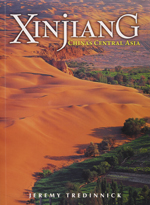
Xinjiang: China’s Central Asia
(Odyssey Illustrated Guides)
Jeremy Tredinnick
Hong Kong: Airphoto Int. Ltd. 2012
480 pp., colour ills., $29.95, £17.95
ISBN: 978-9622177901
敦煌学和科技史
Dunhuang Studies and the History of Science and Technology
王进玉 Wang Jinyu
Lanzhou: Gansu Education Press 2011
550 pp. RMB ¥78
ISBN: 978-7-5423-2395-8
Влияние культуры Китая на процессы инкультурации Средней Азии и Южной Сибири в домонгольское время
The Influence of Chinese Culture on the Processes of Inculturation of Central Asia and Southern Siberia in the pre-Mongol Period
Elena Borisovna Barinova
Moskva: Institut etnologii i antropologii RAN 2011
450 pp., ISBN 978-5-4211-0042-3.
Journals
Literature and History of the Western Regions 6 (2012)
朱玉麒 Zhu Yuqi (ed.)
366 pp., 4 pp. plates.
ISBN 978-7-03-030424-7
Center for Studies of Literature and History on the Western Regions
Sino-Platonic Papers 228
(July 2012)
The ‘Silk Roads’ in Time and Space: Migrations, Motifs and Materials
Bulletin of the Asia Institute 22
(December 2012)
The Silk Road 10 (2012)
Exhibitions
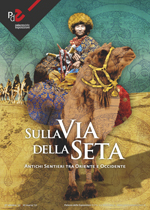
On the Silk Road: Ancient Pathways Between East and West
27 October 2012 – 10 March 2013
Palazzo delle Esposizioni, Rome
Exhibition organized by American Museum of Natural History, New York in collaboration with Azienda Speciale Palaexpo and Codice. Idee per la Cultura, Torino.
This exhibition illustrates the different cultures along the Silk Road with reconstructions of four iconic cities: Chang’an, today’s Xi’an; Turfan, an oasis city in the Gobi Desert; Samarkand, a major centre of trade and culture; and Baghdad, seat of the Arab Caliphate.
A section produced exclusively for the Italian exhibition explores the relationship between Italian cities, particularly Venice and Genoa, and the Far East in the final few centuries of the Middle Ages.
Buddhism Along the Silk Road: 5th–8th Century
2 June 2012 – 10 February 2013
Metropolitan Museum of Art
New York
Drawing together objects from India, Pakistan, Afghanistan and the western reaches of Central Asia the exhibition illuminates a remarkable moment of artistic exchange. At the roots of this transnational connection is the empire established the end of the fifth century by the Huns, which extended from Afghanistan to the northern plains of India.
Dunhuang: Buddhist Art at the Gateway of the Silk Road
China Institute Gallery, New York
7 February – 9 June 2013
Situated at a major crossroads of the ancient Silk Road, Dunhuang is one of the world’s major cultural heritage sites. This exhibition showcases the customs and practices of local Buddhists and illuminates the significance of the city as a crucial point of cultural exchange. The exhibits include sculpture, painted clay reliefs, calligraphy, Buddhist scriptures, and modelled bricks from the caves
Pure Land: Inside the Mogao Grottoes at Dunhuang
Run Run Shaw Creative Media Centre, Hong Kong
Pure Land brings to life the story painted as a single composition on the north wall of Cave 220, the Eastern Pure Land of the Medicine Buddha, Bhaisajyaguru. Visitors are immersed in a large 360-degree panoramic projection theatre that gives the experience of being inside a cave temple and seeing its Buddhist wall paintings on a one-to-one scale.
DunHuang’ın Renkleri: ipek Yolu’na Açılan Büyülü Kapı
The Colours of Dunhuang: The Magical Door Opening to the Silk Road
21 November 2012 – 7 January 2013
Mimar Sinan Fine Arts University’s Tophane-i Amire Culture & Arts Center, Istanbul Presented in the show are some 2,164 artifacts, made up of wall paintings, sculptures, small wall reliefs, ancient musical instruments as well as a number of sutras, or ancient scriptures, and several examples of ancient Chinese brick carvings.
Treasures of Ancient China
to 23 February 2013
Topkapı Palace, Istanbul
Includes five Terracotta Army sculptures and over hundred artefacts on loan from prominent Chinese museums.
Donor Profile
PK Lom Pabhassaro
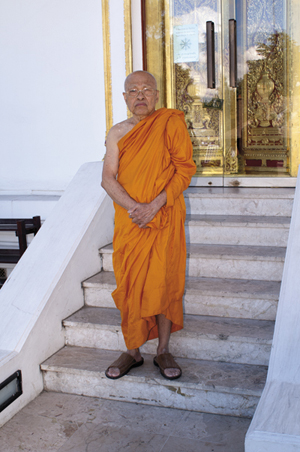
This is a new occasional feature for the newsletter where some of IDP’s users, friends and supporters introduce themselves. The pieces are accompanied by short videos on IDP’s YouTube channel.
My name is Phrakru Samulom, I come from Thailand and I came here in 1976 to work as a teacher of Buddhism and meditation. I live at the Buddhapadipa Temple or Thai Temple in south London. This temple was set up in 1968 by the King of Thailand, who also came to open the temple when we moved from Christchurch Road near Richmond Park in 1976. We teach Buddhism according to the Theravada school, practised in Thailand, Sri Lanka, Burma, Cambodia and Laos.
We get up at 6am to have breakfast at 7am. In Buddhist countries we go out to collect alms. Here it’s not very convenient because the people who want to give alms might live far from the temple. So people bring food for breakfast or lunch. 8am is time for chanting and meditation practice.
In the afternoon we have school visitors or university students to learn about meditation and Buddhism. I also teach a class on the introduction to Buddhism. At 6pm we have an hour-long meditation session.
Sometimes we go out of the temple if people die, get married, need a blessing, etc. Sometimes people come here also. Especially if someone dies, our role is to comfort the family. This is very important.
Obituary: Werner Sundermann (1935–2012)

We regret to announce the death of our esteemed colleague Werner Sundermann who passed away on Friday, 12 October 2012 after a long illness.
The Turfan Study Group (‘Turfanforschung’) has not only lost a former colleague and director, but also a scholar of the highest standing who was well-regarded worldwide. Even after his retirement he stayed close to us, taking part in our activities and supporting us with literature, discussions and advice.
He completed his doctorate in 1963. In 1970 he started work in the Turfan research group founded in 1965 at the German Academy of Sciences, which he and his colleagues made internationally known through editions of new textual material. In 1984 he completed his second doctorate (habilitation). From 1993 to 2000 he was director of ‘Turfanforschung’. In 1992 he became honorary professor in the Institute of Iranian Studies at the Free University Berlin.
He was an extraordinary member of the Class of Humanities of the Berlin Brandenburg Academy of Sciences and Humanities, a member of the Academia Europaea and also corresponding member of the Istituto Italiano per il Medio ed Estremo Oriente, of the North Rhein Westphalian Academy of Sciences and Humanities, of the Danish Academy and of the British Academy.
For further information see the Turfanforschung website or see the BBAW website for his complete bibliography.
IDP Worldwide
IDP Beijing
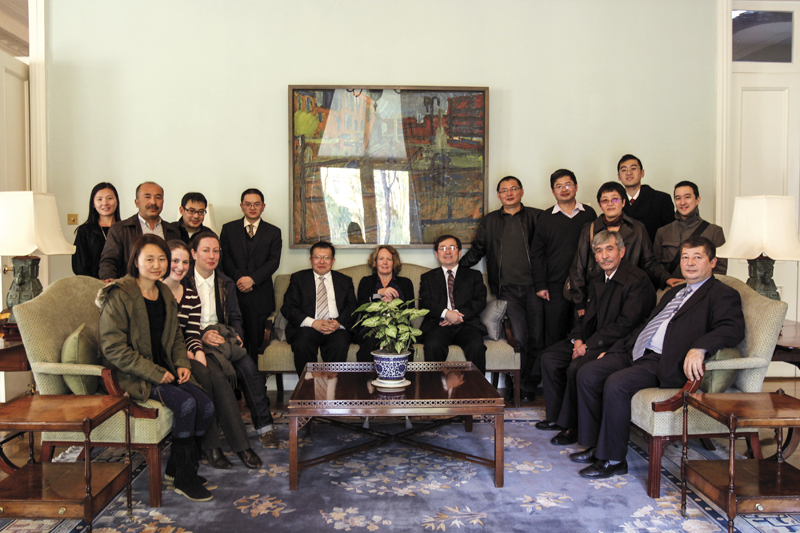
NLC celebrated the 10th anniversary of the launch of the IDP Chinese website on 16 November 2012. NLC hosted the exhibition ‘Documenting Dunhuang: Historical Photographs from the Late Qing and Republican Periods’, including 100 historical photos. NLC also hosted a roundtable with some Dunhuang scholars on the same day to discuss the current status and the future of IDP.
The IDP studio at NLC uploaded 20,160 images from January to November 2012, more than any year previously. We will try to digitise faster and upload more images.
The IDP NLC server OS was upgraded at the end of June 2012. The new system is faster and more stable, so it ensures that we can provide better a service for our users. The 4D software was also upgraded to v.12 in early July 2012.
Mr. Wang Xing (王兴), undergraduate from Beijing Jiaotong University, has been working at IDP NLC as a volunteer since February 2012. He comes to IDP NLC every Wednesday afternoon. He helps us to copy some images from DVD discs to mobile hard drives and creates an excel file to record the details of every disk.
Miss Li Qiuyu (栗秋雨), undergraduate from the Technical College for the Deaf at Tianjin University of Technology, worked at IDP NLC as a volunteer from 1–17 August during the summer holidays. She also helped us to copy images from DVDs to mobile hard drives.
IDP Dunhuang
Thanks to the combined efforts of colleagues, we have recently completed the photography for all 381 volumes of Dunhuang manuscripts within the IDP Dunhuang collection, having taken a total of 4467 digital images. Of these, 1200 have been uploaded to the IDP servers, and the remaining 3000 are currently undergoing manipulation. The background will be replaced, a digital ruler inserted, and the database entries completed, before then uploading the images to the internet. We are striving to have the first stage of this work complete by the middle of next year.
On 20 November 2012, the Dunhuang Academy unveiled an exhibition entitled ‘Colours of Dunhuang — A Magic Gateway to the Silk Road’ at Mimar Sinan University in Istanbul (see Exhibitions. It was organised in collaboration with the China Arts and Entertainment Group and supported by the Chinese Ministry of Culture, the Turkish Ministry of Culture and Tourism, and the Chinese Embassy in Turkey.
The exhibition was a key event in Turkey’s ‘Chinese Culture Year’, and also the largest exhibition of Dunhuang art to be held abroad in recent years. The exhibition displayed almost a hundred artistic treasures excavated from the Mogao caves at Dunhuang, including manuscripts, ornamental tiles, painted sculptures, mural replicas, and even entire cave reconstructions. Among these, the famous mural depicting the Jataka tale ‘The Story of the Deer of Nine Colours’ from Mogao Cave 257 (from the Northern Wei Dynasty), and those of hunting from Mogao Cave 249 (Western Wei) were featured as fine examples of China’s artistic heritage. Performing artists skilled in Dunhuang dance and Chinese tea ceremony were also invited, in order to demonstrate the essence and elegance of Chinese traditional culture. A roundtable on Dunhuang culture was also held the same day.
In her speech at the exhibition opening, Professor Fan Jinshi, expressed the belief that Dunhuang culture can be considered both the foundation of Chinese culture and a merging of elements absorbed from outside. She notes that in this Sino-Turkish Culture Year, holding this exhibition is beneficial to the continued growth of Sino-Turkish relations and to enhancing the friendship between the two nations. The exhibition is due to close in Turkey on 13 January 2013.
IDP France and IDP Japan
Dr. Shouji Sakamoto, from Digital Archives Research Centre, Ryukuko University, Kyoto is currently at Bibliothèque nationale de France, Paris on a collaborative project with Dr. Nathalie Monnet. He is using a high-resolution digital microscope to investigate the paper of Dunhuang manuscripts in the Pelliot collection, following on from his work in London. Dr. Sakamoto will take over 30,000 microscopic images of the paper, and all the data will be appear on a new paper database they will develop in 2013. Details of Dr Sakamoto’s work on the manuscripts in London, along with his images, are available through the IDP website.
IDP Korea
Jisun Hwang joined IDP Korea in March, 2012 as successor to researcher Seulki Lee in the management of Korean webpage server and administration of events. In August, Dr. Kwanghun Jung joined the team as a senior researcher in charge of translation of The Dictionary of Dunhuang Studies 敦煌學大辭典 (Ji Xianlin 季羨林 (ed.)). Dr. Jung also actively participates in various research project in IDP Korea.
RIKS (Research Institute of Korean Studies, Korea University, Korea) and GCBS (Geumgang Centre for Buddhist Studies, Geumgang University, Korea) signed a cooperation agreement last August. GCBS is a centre established in 2003 for various fields of research in Buddhist studies and culture. The parties have already collaborated in translating and publishing the dictionary.
Also in October, a joint conference with Turkmenistan was held at Korea University. Entitled ‘Central Asia, Korea and the Silk Road as a Cross-cultural Network’, the conference had several presentations and following discussions. Participants included Yoonhee Hong, HK research professor and Kwanghun Jung, senior researcher from IDP Korea, and three researchers from The Academy of Sciences of Turkmenistan including Ashirov Annakurban, the director of the Academy.
IDP Sweden
Artefacts and photographs from the Hedin collections in Sweden started to come online through IDP in 2012. The images and data are pulled form the Swedish Open Cultural Repository (SOCH) using an API. This is a new model for IDP and was tested earlier this year. Now it is working, more entries on SOCH will be tagged and thus identifiable as relevant to IDP.
IDP Russia
An international conference, ‘Tanguts in Central Asia’, was held in the Institute of Oriental Manuscripts on 22–23 June 2012.
The conference was in honour of the 80th birthday of Professor Evgeniy Kychanov, the world renowned specialist in the field of Tangut and Chinese studies.
Leading scholars in the field worldwide attended, including Nie Hongyin, Du Jianlu, Lin Ying-Chin, K.J. Solonin and Sun Bojun.
The conference papers were published as a Festschrift for E. I. Kychanov «Тангуты в Центральрой Азии» (Tanguts in Central Asia). The collection of 36 papers (19 in Russian and 17 in English) was presented for the Jubilee on 22 June at the plenary session. The Institute also published papers from the 2012 conference on Dunhuang studies: Dunhuang Studies: Prospects and Problems for the Coming Second Century of Research / 敦煌學:第二個百年的研究視角與問題 / Дуньхуановедение: перспективы и проблемы второго столетия исследований. (Edited by I. Popova and Liu Yi. St. Petersburg: Slavia Publishers, 2012).
Preparations are currently underway for a conference on Oldenburg to take place at the Institute in late September 2013.
IDP is also discussing a potential collaboration with the Hermitage on their Central Asian collections.
IDP Germany
The joint digitisation project of the Berlin Brandenburg Academy of Sciences and Humanities (BBAW) and the Berlin State Library – Prussian Cultural Heritage (SBB-PK), in cooperation with the Union Catalogue of Oriental Manuscripts in German Collections (Goettingen Academy of Sciences), financed by the German Research Council (DFG), has now reached its final stage.
By the end of this year the digital images of all c.40,000 manuscripts and block prints preserved in the Berlin Turfan collection will be freely available online through the IDP database. Additionally, a first part (c.100 fragments) of the small collection of Turfan manuscripts preserved in the Museum of Asian Art, Berlin, will be added to the IDP database by the staff of the DFG digitisation project.
Thanks to the reduced costs for the scanning of the very large number of Sanskrit fragments we were able to spend some additional funds on the restoration of as yet undigitised Tocharian fragments. As a result of this, now the images of all the Tocharian fragments in Berlin are available on the IDP database. When we first started digitisation in October 1997 we benefited greatly from the experience in this field gained by the TITUS Project of Frankfurt University under the direction of Professor Jost Gippert. So it was a great pleasure for us to give the final report on our project at the workshop dedicated to the 25th anniversary of the TITUS project in December 2012 (TITUS 25) as part of the International Conference on ‘Historical Corpora 2012’ (6–9 December 2012, Goethe University, Frankfurt, Germany).
The DFG financed part of the digitisation project will end on 31 December 2012 and we will have to say goodbye to Anett Brüsemeister and Markus Reinsch — our present DFG digitisation staff. And it is the right time to thank all those who participated in and/or supported our project in the course of time: the German Research Council (Scientific Library Services and Information Systems — LIS), the Oriental Department and the Department for Reproduction and Conservation of the Berlin State Library, Jost Gippert, Claudius Naumann, Ramin Shaghagi, Götz König, Kati Brauchmann, Anja Klier, Barbara Meisterernst, Anne Peters and Andrea Schlosser. Many other people contributed at various points.
According to availablity of time and financial support we will continue to transfer the digital images from our Digital Turfan Archive I to the IDP database and at the same time to add data from published editions and catalogues.
IDP UK
People
It has been a busy period in terms of staff changes at IDP. We were very sorry this year to say goodbye to Imre Galambos, Alastair Morrison and Kate Hampson. We also said a temporary farewell to Abby Baker who went on maternity leave (and congratulations on the birth of her daughter).
Imre started with IDP in 2002 as Overseas Project Manager and became a Research Manager in 2003, working closely with Sam van Schaik on palaeographical and codicological research and publishing widely. He has now become Lecturer in Pre-Modern Chinese Studies at Cambridge University, and we look forward to continuing to work with him on joint projects in his new role.
Alastair joined in 2003 taking over Imre’s responsibilities for networking and digitisation and was soon promoted to become Overseas Project Coordinator. During this time he developed excellent working relationships with IDP’s many partners, especially in China, and significantly expanded our activities there. He received his doctorate from SOAS in 2012. He has now taken the position of Partnership and International Development Manager at Bournemouth University.
Kate joined IDP in 2001 as a half-time Project Administrator and her support over the years has been invaluable. We wish her well in her retirement. Josef Konczak joined the team in May as a half-time Imaging Assistant, taking over Abby’s work in this area.
Sarah Mullan and Emma Goodliffe joined us in September and October respectively, Sarah taking over from Kate and Emma from Alastair. We welcome them all to IDP.
Volunteers
Thanks to Serena Biondo for her help over this year on the Tibetan manuscripts and to Zhang Qin, who worked as a volunteer for IDP in July. She also did translation and offered general help during the IDP conference in November. Thanks also to the other helpers at the conference: Siqin Brown, Lorna Komenda, Caroline Lound, Farida Seddon and Ilse Timpermann.
Events
Dunhuang and Hong Kong: Gateways to Ancient and Modern China
This half-day event on 14 May included lectures by Professor C.F. Lee (Director, The Jao Tsung-I Petite École of the University of Hong Kong), Professor Fan Jinshi (Director, The Dunhuang Academy) and Susan Whitfield, followed by a reception. This event was initiated by Jao Tsung-I, who proposed organising lectures on the subject of Hong Kong and Dunhuang on the occasion of the 15th anniversary of the Hong Kong Special Administrative Region. Held in the British Library Conference Centre, it was jointly organised by IDP with the Hong Kong Economic and Trade Office and was attended by around 150 people.
Wikipedia Editathon
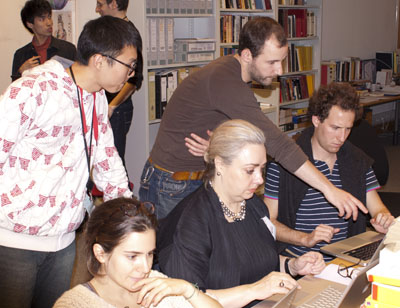
Wikipedians, students from UCL, SOAS and Birmingham University, scholars and IDP staff participated in the IDP Wikipedia Editathon held from 23–26 October (right). During the four days they added, edited and updated material on Wikipedia. For a full report see the Wikipedia:GLAM/BL/IDP/Report page. This was one of the activities under an AHRC grant.
IDP China: 10th Anniversary
Susan Whitfield, Vic Swift and Emma Goodliffe were joined by Baroness Tessa Blackstone, Chair of the British Library Board, HE Sebastian Wood, the British Ambassador to China, colleagues from IDP Dunhuang and the Xinjiang Institute of Archaeology, scholars and press at this event in Beijing.
Collaborations
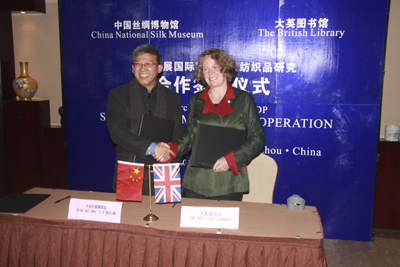
The Chinese National Silk Museum in Hangzhou held celebrations for its 20th anniversary in late November 2012. Susan Whitfield attended and, as well as presenting a short paper on IDP, also signed a Memorandum of Understanding (MoU) with Zhao Feng, Director of the Museum (pictured right). The MoU covers collaboration on the cataloguing of Central Asian textiles on the IDP database and website. It is hoped that this work will start in 2013.
Xu Shenggen from the Ningxia Academy of Sciences, China, came to London to discuss a collaboration on Tangut manuscript conservation, cataloguing, digitization and publication with IDP.
Zhao De’an, Director of the Northwest University for Nationalities (Lanzhou), and a team of researchers discussed with IDP the publication of a series of facsimile volumes of the Stein Tibetan manuscripts.
Funding
AHRC
IDP hosted a workshop of its UK Academic Advisory Group as part of the AHRC-funded project to discuss the results of the user survey, the Wikipedia Editathon and the IDP redevelopment.
The online user survey received over 100 responses. A summary report will be added soon.
The AHRC grant will end in March 2013 and further funding is currently being sought. We welcome all donations.
For regular news of IDP’s activities see the quarterly reports on the IDP Blog.
This digital version of IDP News is based on the print version of the newsletter and some links and content may be out of date.
This issue, No. 40, was published Winter 2012-13.
Editor: Susan Whitfield
Picture Editor: Rachel Roberts
ISSN 1354-5914
All text and images copyright their creators or IDP, except where noted. For further information on IDP copyright and fair use, please visit our Copyright page.
For further information about IDP please contact us at [email protected] or visit our Contact page.